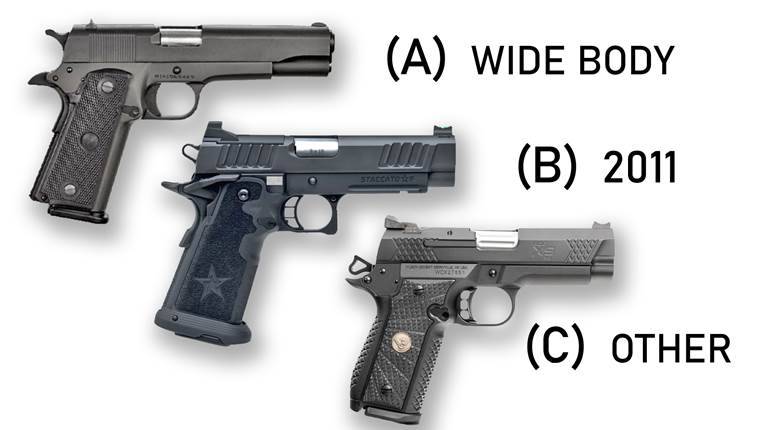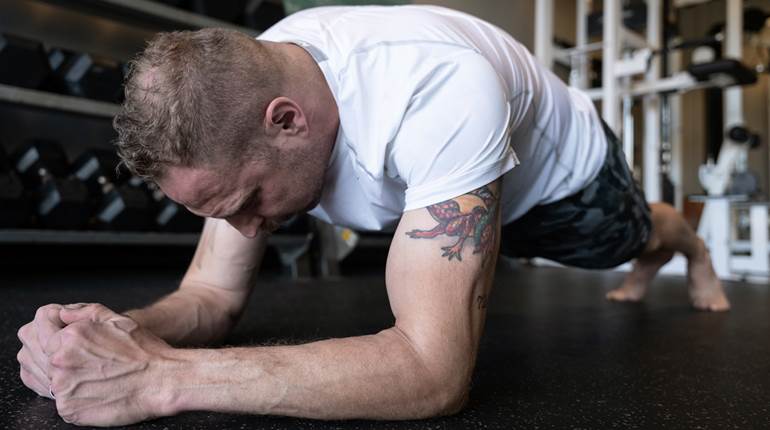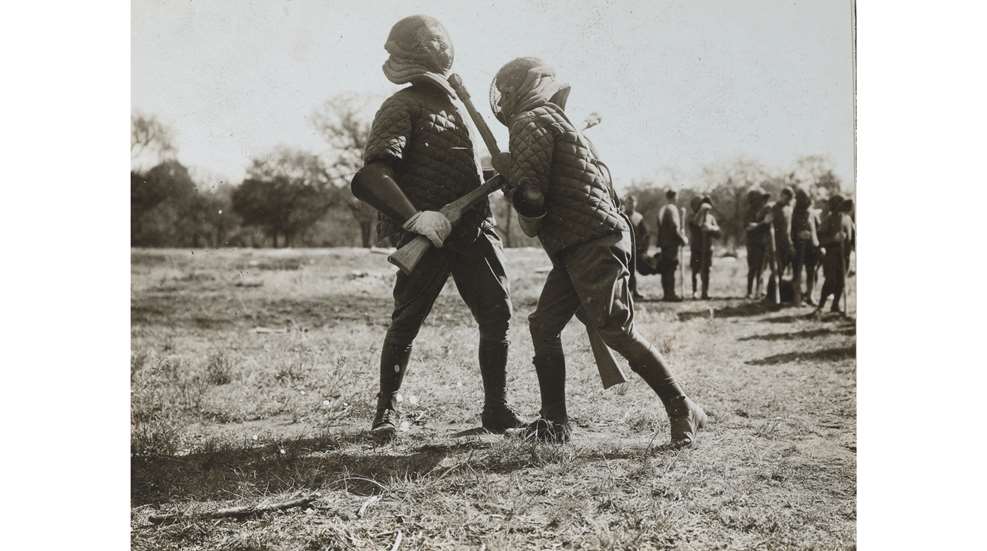
All test documents, and accompanying photographs, are located in the National Archives and were digitized as part of Archival Research Group’s quest to preserve these fragile documents for posterity.
Following the post-World War I draw-down, the U.S. Army, perhaps realizing it was no longer destined to be simply a frontier or occupation force, wanted to stay abreast of technological developments and refine its own existing equipment as much as possible. One way it decided to do this was by using the Experimental Division of the Infantry School, located at Camp Benning, Ga., which tested items that we now take for granted, as well as some that were ultimately confined to the dustbin of history.
The Camp Benning of the 1920s was in the early stages of becoming what it is today—the world’s preeminent training location for infantrymen, particularly new infantry lieutenants. Spanning the Georgia-Alabama border, Camp Benning provided ample room for maneuvers, as well as, eventually, detailed classroom instruction. But academics wasn’t the only thing that the Infantry School was concerned with, and it had three sections placed under its banner: the Instruction Division, the Administration Division, and the Experimental Division (soon called the Department of Experiment). While the first two are fairly self-explanatory, the third was forward-looking and tasked with determining how to make the individual soldier’s equipment more effective.
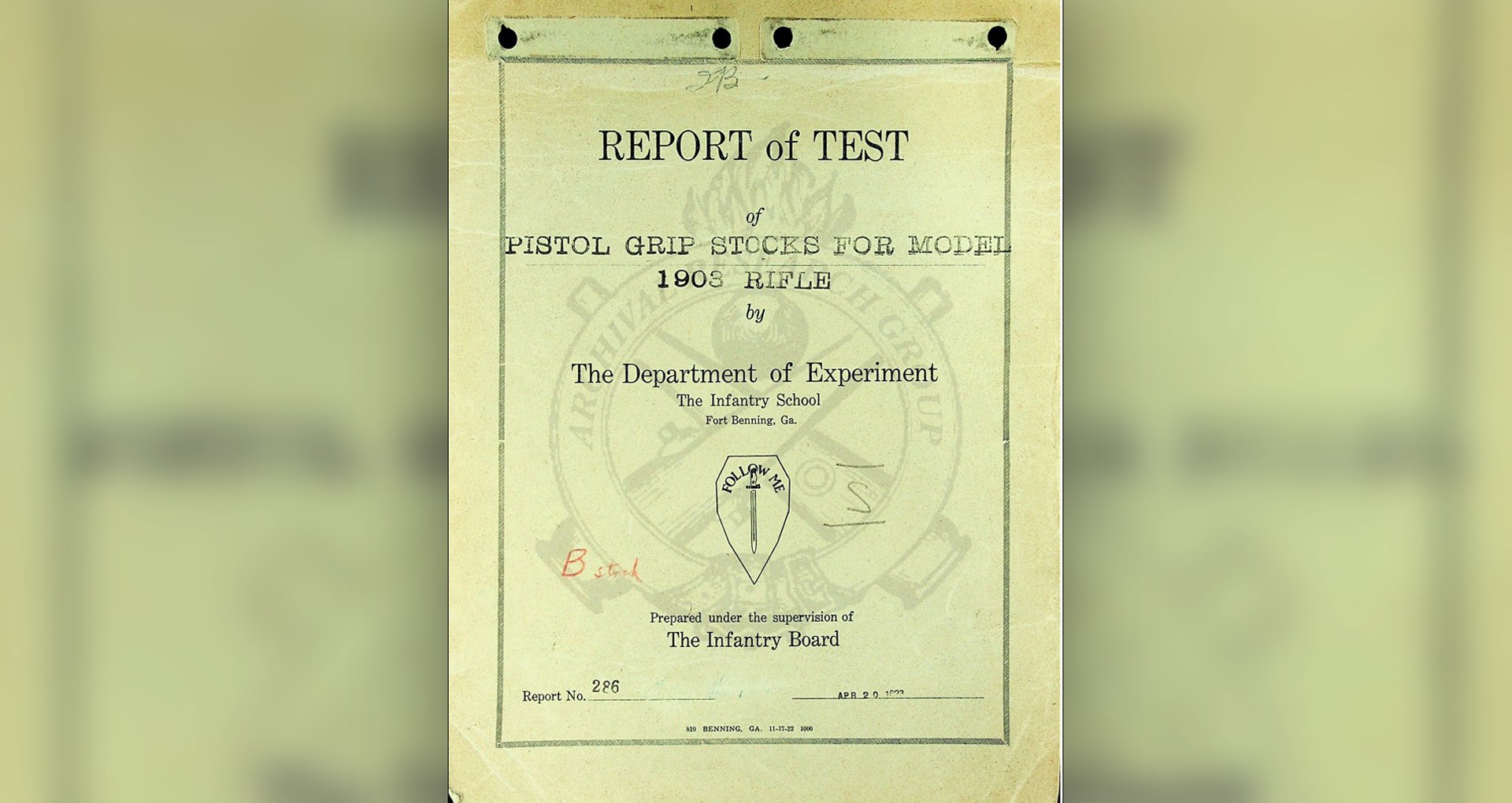 The Infantry School at Fort Benning still uses almost the same logo today, just with the bayonet flipped 180 degrees. The cover page (above) that accompanied most Department of Experiment reports.
The Infantry School at Fort Benning still uses almost the same logo today, just with the bayonet flipped 180 degrees. The cover page (above) that accompanied most Department of Experiment reports.
Importantly, it was not a replacement for the Ordnance Department, the arsenals at Springfield or Rock Island or the testing conducted at Aberdeen Proving Ground in Maryland. Instead, the February 1920 volume of the Infantry Journal states that the tests conducted at Fort Benning are designed to, “Supplement that work by conducting field tests of material that has stood the arsenal proofs and laboratory tests.” Importantly, they sought to identify any gap between any success in the laboratory or controlled workshop and the practical reality of that same item when placed in the hands of “soldiers of average intelligence” in simulated battlefield conditions. In addition to field testing new equipment, the department also did “original research work connected with firearms and shooting” and would send the results and recommendations of such tests to possible decision-makers. As a bottom line, though, the Department of Experiment existed to study and test the blending of the human element with already-proven technology and see what improvements might be made.
Receiver-Mounted Sights For The Model Of 1903
Despite there being many more M1917 rifles in the U.S. inventory following the end of WWI, it was determined that the Model of 1903 rifle would remain the primary service arm of American forces moving forward. However, one part that many riflemen particularly liked about the M1917 was noticeably absent on the M1903—a receiver-mounted aperture sight. Therefore, in 1923, the Department of Experiment set about “to determine the suitability for general service use of certain experimental receiver sights for the model of 1903 rifle …”
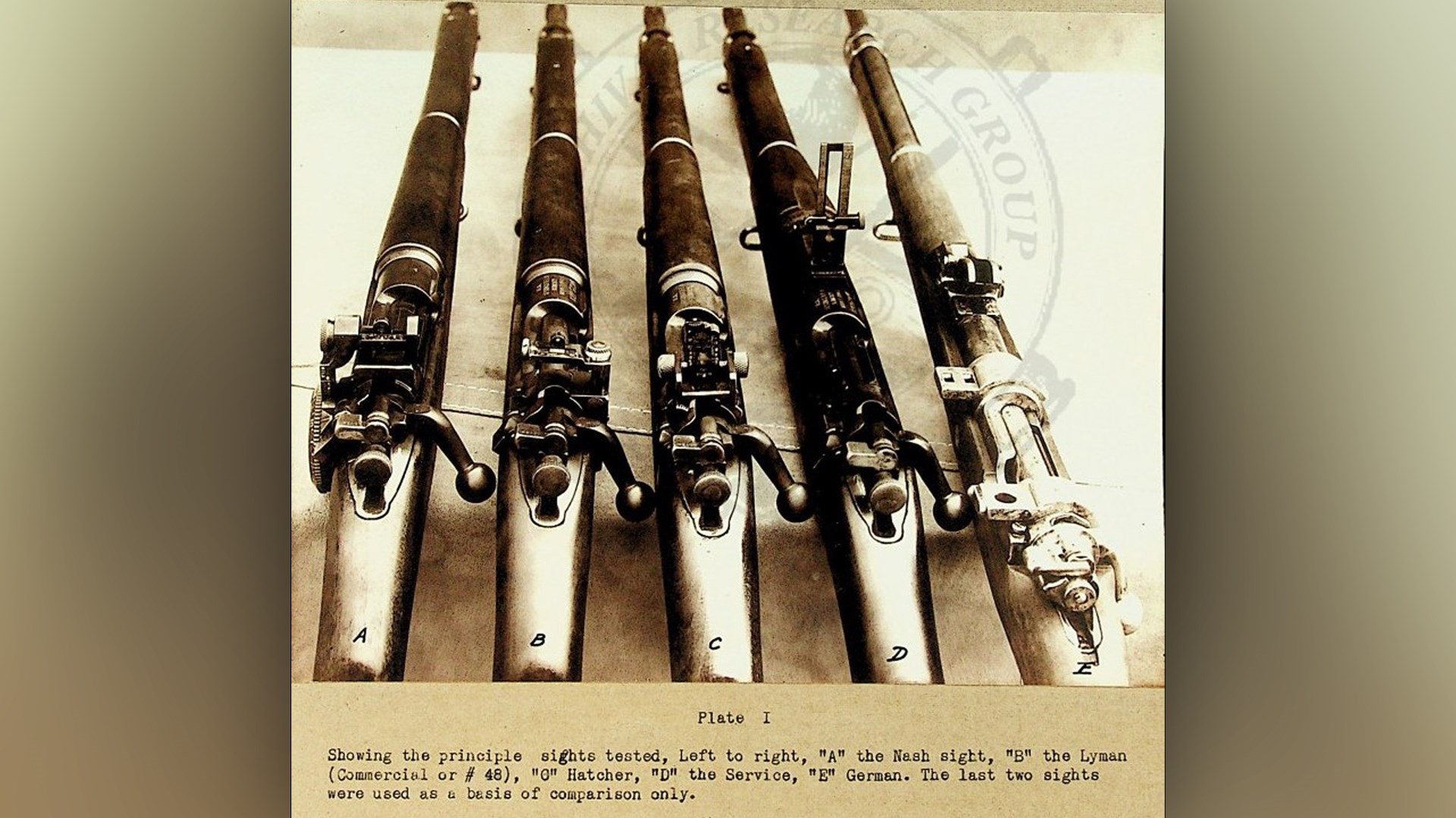 The primary tested aperture sights as viewed from the rear. The rifle mounting the Hatcher sight could easily be mistaken for a M1903A3 at a quick glance.
The primary tested aperture sights as viewed from the rear. The rifle mounting the Hatcher sight could easily be mistaken for a M1903A3 at a quick glance.
The interest in having a receiver-mounted aperture sight was driven by two sources–positive experience with the M1917 rifle, which excelled in quickly acquiring and striking targets that had limited exposure time, and the existence of many aperture sights in the target-shooting community. In fact, the test document stated that “[The M1917 sight] is in many respects the finest war sight ever issued on a military rifle. For quick work at short range it is an admirable sight.” Therefore, the Department of Experiment embarked upon a formal test of available sighting options and reported their findings back to the Infantry School.
The Contenders
The test considered eight aperture sights and three control sights: a standard M1903 service sight, an M1917 sight and a German Gewehr 98 sight. The aperture sights most thoroughly tested, in batches of five a piece, feature some well-known names–Lyman, Hatcher, Nash and Enfield. Other sights by McDougel, Harken, Barrett and a Marine Corps-designed entry rounded out the contenders. This article will concentrate on the first three sights, as they received the most complete write-up and greatest consideration by the testing officials. While all three of these sights were both windage- and elevation-adjustable, they had some key differences.
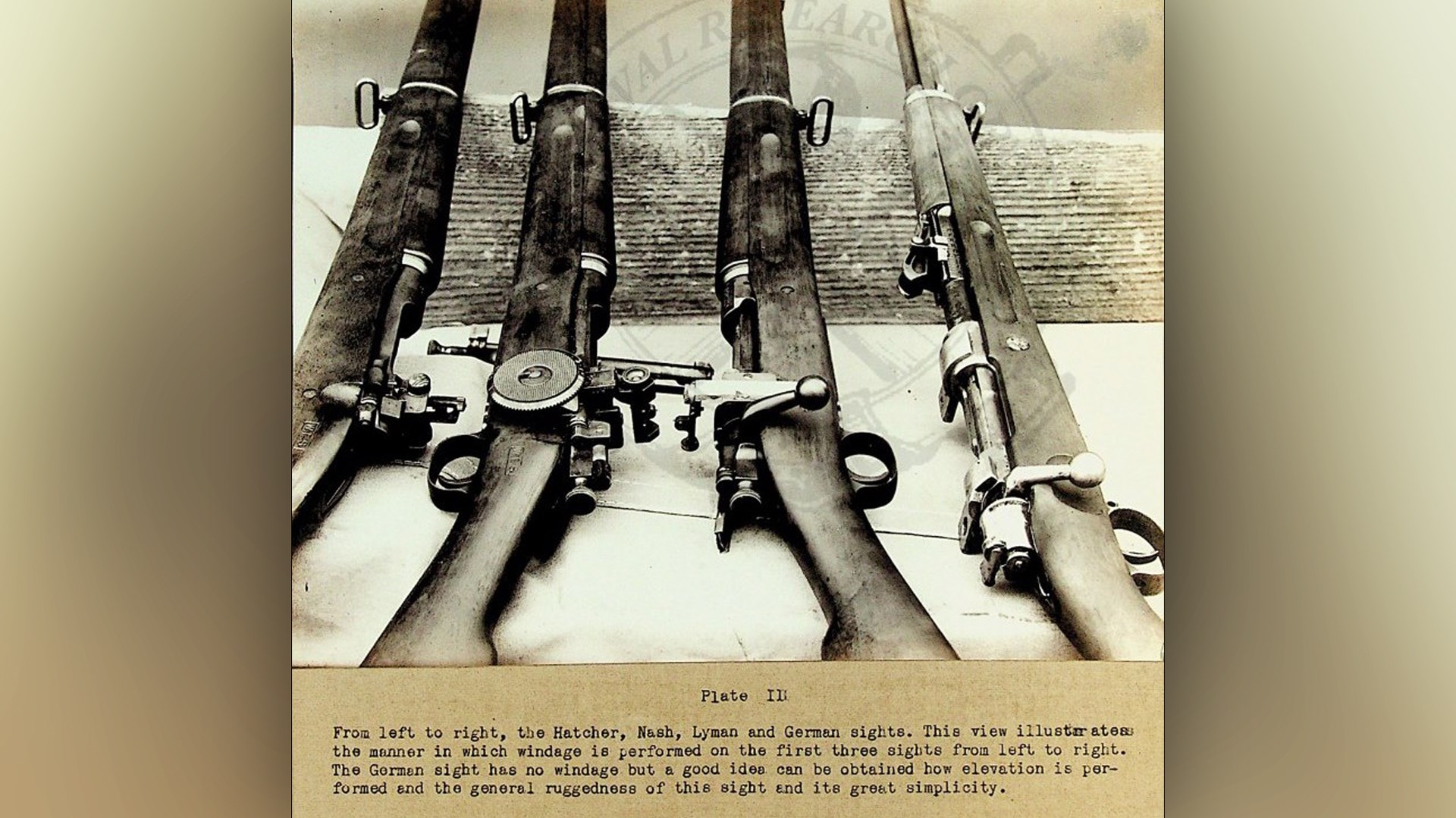 The primary tested aperture sights as viewed from the side on which their windage is adjusted. Note the massive disc on the Nash and the rear ladder on the Hatcher.
The primary tested aperture sights as viewed from the side on which their windage is adjusted. Note the massive disc on the Nash and the rear ladder on the Hatcher.
The Lyman sights tested were the well-regarded Lyman No. 48—both standard and with a modified base. The report author notes that “in its commercial form [the Lyman No. 48] is primarily a target sight, although it is popular for hunting purposes on account of its compact design.”
Both the Lyman and Nash were of similar design in that they attached to the side of the rifle, with a single aperture being centered with the bore by means of a horizontal cross-arm running across the receiver (which was the source of some problems discovered during testing). The chief difference between the two is that the Lyman mounted to the right side, just forward of the bolt handle, and required minimal modification, while the Nash was attached to the left of the rifle via a fairly large, milled wheel. While the Nash’s wheel allowed for easy dismounting for cleaning, it required changes to the receiver itself. Both were windage- and elevation-adjustable.
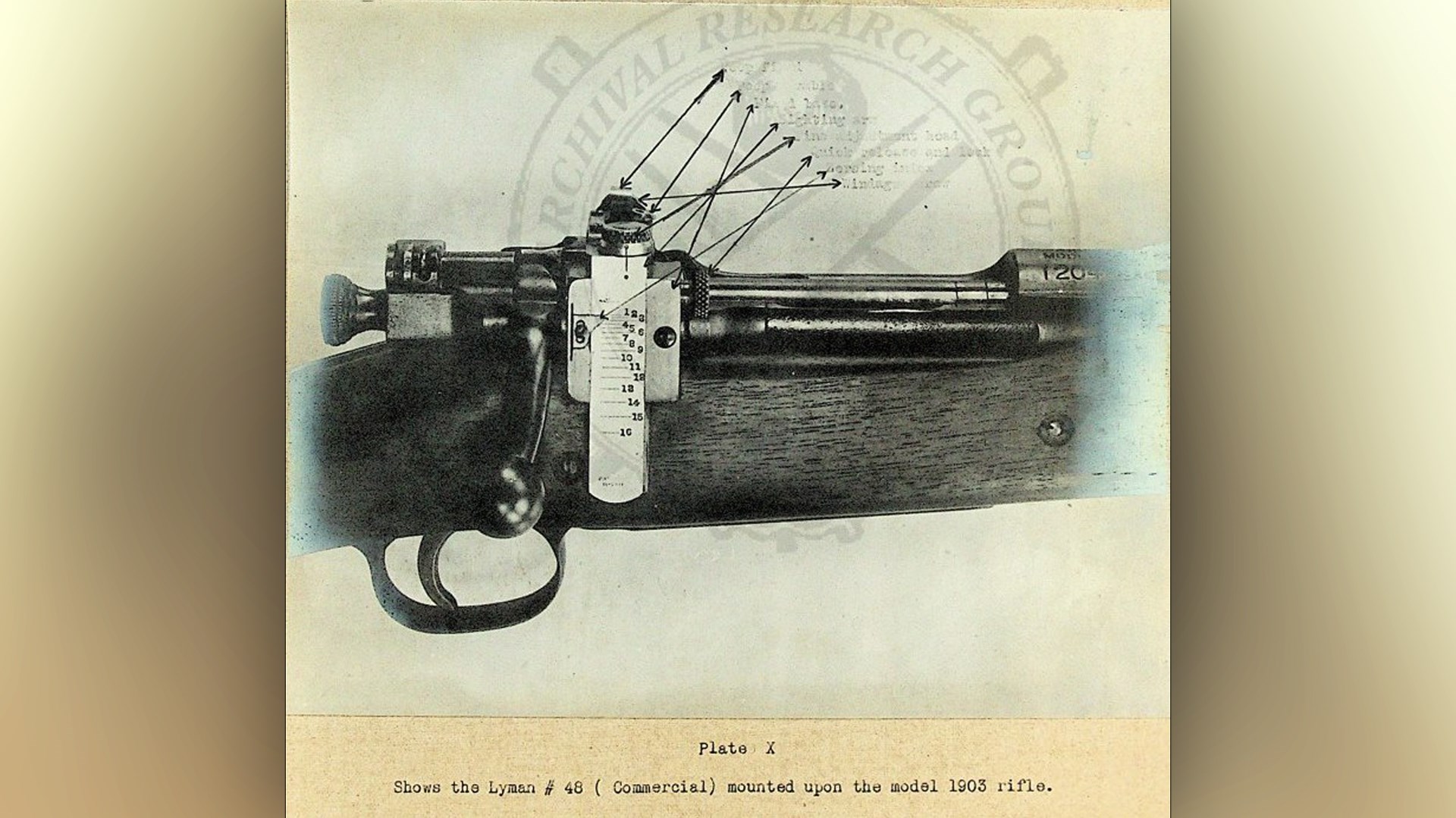 A profile shot of the standard commercial Lyman No. 48.
A profile shot of the standard commercial Lyman No. 48.
The Hatcher rear sight—designed by Capt. James L. Hatcher, brother of the somewhat more famous Ordnance Corps officer and NRA Technical Editor Julian Hatcher—was instead “easily attached to the rifle by three screws tapped into the receiver bridge, no changes to the rifle being necessary.” By location and general design, the sight appears quite similar to the later M1903A3 rear sight (likely no coincidence) in that the sight was protected by metal wings and adjusted by small drums. Instead of a sliding ramp to control elevation, however, as on the later sight, the Hatcher featured a small folding leaf with an aperture. While flattened, the sight had a battle sight of approximately 200 yards, and when flipped up, it could range up to 1,200 yards.
The Tests
The aperture sights were put through three tests:
- Slow fire at 200, 600 and 1,000 yards, fired by expert riflemen from the prone position and designed to determine the best adjustment features and “utmost accuracy.” The infantry equivalent of “bench-resting” a new rifle doesn’t show the shooter how it will perform under combat conditions, but it does give the shooter a chance to focus in on the sight itself and identify any features (good or bad) that reveal themselves under such scrutiny.
- Firing up “deliberately indistinct targets” during a “skirmish run” by a selection of rifleman with different skills–selected to represent the average shooter quality resulting from wartime emergency training. This test was similar to modern military qualifications in that it featured silhouette targets mimicking enemy soldiers in different positions and featured a limited time to shoot the course of fire. Interestingly, “In this test the targets were purposely of an indistinct nature in order to bring out the possibilities of a sighting system devised to aid quickness with accuracy of aim under conditions simulating, to a reasonable degree, an enemy target.” Once again, the firing was from the prone position, with target ranges at 200, 300, 350, 400, 500 and 600 yards.
- The third test was the same as the second, but instead employing “Distinguished Experts” in place of the average soldiers.
The Results
The Lyman No. 48 was deemed “an excellent target sight” but the testers highlighted that “care is required in making [adjustments] and the shooter is required to turn the piece to the left […] to a considerable extent when making those adjustments …” and that there “… is a tendency to become confused in making changes of sighting when using the screw and the position of the figures indicating the range are confusing to the shooter when the piece is rolled to the left […] as the [numbers] do not appear upright …” The modified Lyman was a “distinct improvement” in that the numbers “will appear upright when the rifle is turned on its side,” a more “military” way of graduating the sights, and contrasting numbers.
The Nash was both accurate and “readily understood in its windage and sight settings”, but testers noted that “The sight has too much looseness and there is no means to lock it secure in position. The big dial is easily moved by inadvertently rubbing against it.”
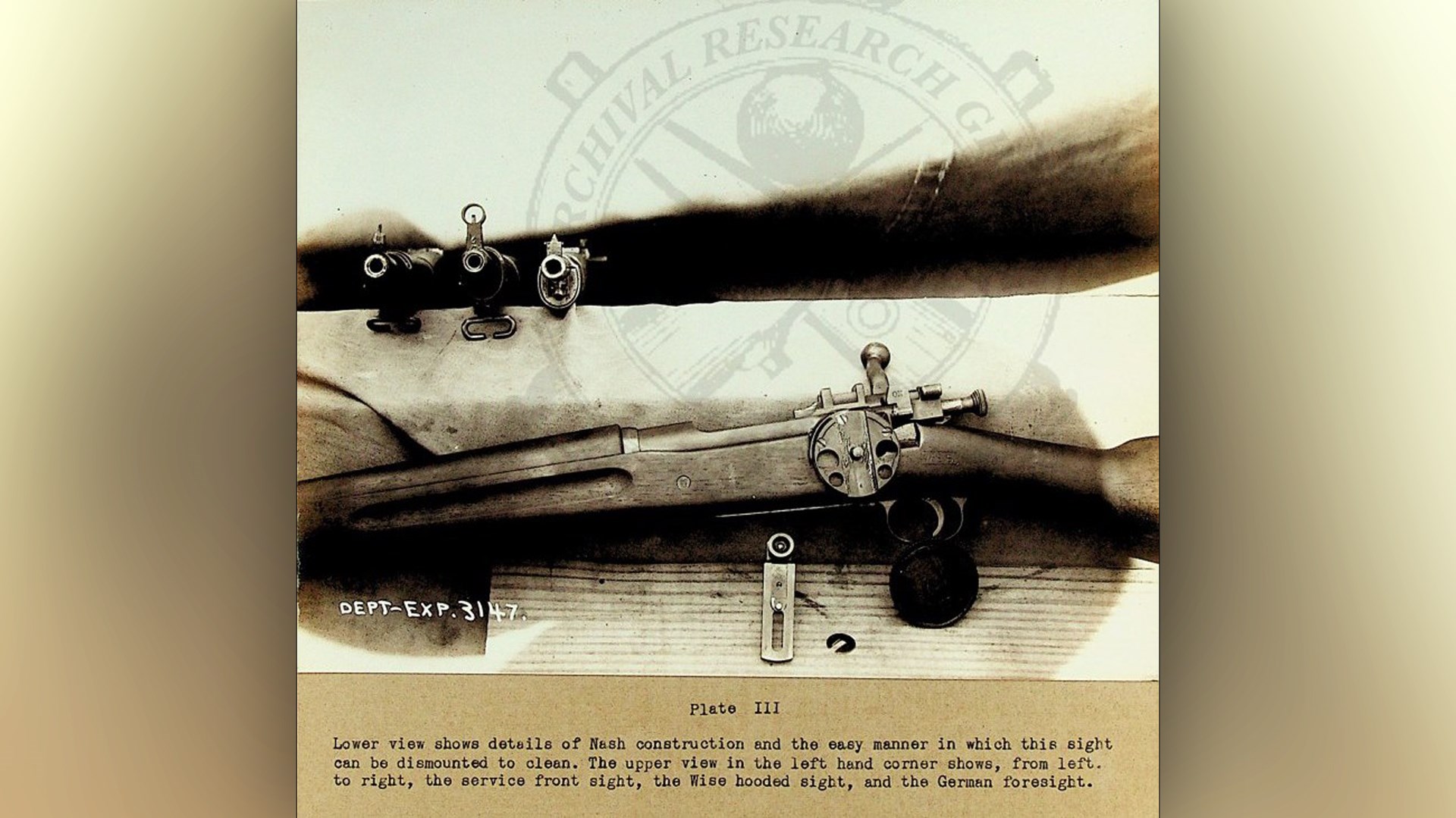 A profile shot of the Nash sight dismounted for cleaning or transport.
A profile shot of the Nash sight dismounted for cleaning or transport.
However, the biggest complaint, and the one most likely to doom a contemplated military sight, was that both the Lyman and Nash sights showed a tendency to jam when subjected to dust and grit, and that both also were deemed “prone to injury from a blow when raised above the point-blank position.” Since military forces, then and today, must expect some degree of abuse, a sight that could easily become rendered mechanically inoperative is generally not going to be acceptable for standard use.
Fortunately, however the tests did discover one entrant that seemed to fit the bill—the Hatcher. The test determined that “[t]he Hatcher sight is the most satisfactory of all the receiver sights tested to date. It is compact, rugged, well protected, and easily attached without [any] changes being required in the receiver other than the tapping of three screw holes in the receiver bridge.” Another great note about the Hatcher was the robust nature of the sight, something that the Lyman and Nash both lacked. The testers specifically noted, “It is an exceedingly strong sight admirably adapted for military purposes and target work.” It did have one major drawback it its tested form, however–it could not be used with stripper clips. While the test doesn’t note why specifically, it appears that the sight, as then mounted, sat slightly too far forward and infringed upon the clip guide integrated into the receiver. Fortunately, while it “detracted somewhat from its value […] it was the impression that this could be remedied at the Arsenal” and that if a “ … receiver sight were adopted for the U.S. Rifle, Caliber .30, Model 1903, this sight is satisfactory.”
The testers recommended a large aperture suited for “close and indistinct” targets and a small aperture designed for sharply defined targets where the greatest accuracy is required, mounted “very close to the eye.”
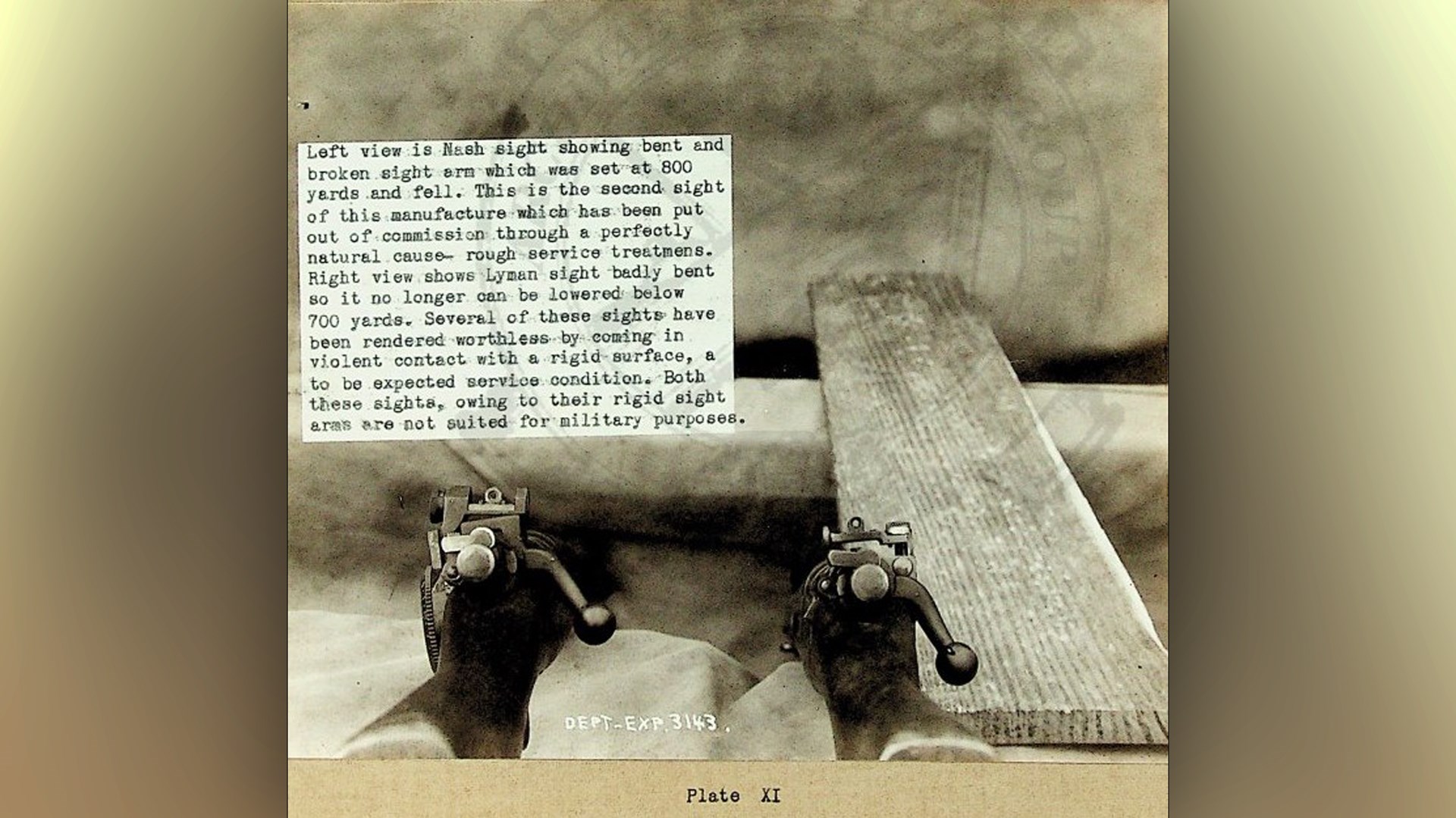 This picture shows probably the biggest fault found in both the Lyman and Nash sights. Because of the way the aperture was suspended over the bore, a hard blow was liable to bend the vertical arm.
This picture shows probably the biggest fault found in both the Lyman and Nash sights. Because of the way the aperture was suspended over the bore, a hard blow was liable to bend the vertical arm.
Department of Experiment testers also took issue with the default “battle sight” of the M1903 being set at 547 yards. In the opinion of the lead officer, “The ‘battle sight’ adjustment should not exceed 300 yards. When so adjusted it is possible to take aim directly at the point it is desired to strike […] Aiming should be a simple, natural act. [..] With our service sight [a soldier] is obliged to take aim nearly two feet under the target at 200 and 300 yards with his ‘battle sight.’”
The Department of Experiment clearly thought highly of the Hatcher sight, and aperture sights in general, for military use, but it was not meant to be. After reviewing the report, Brig. Gen. W.H. Gordon, the president of the Infantry Board, wrote a memorandum on July 31, 1923, to the Chief of Infantry in Washington, D.C., throwing cold water on the whole situation (while still acknowledging the potential of aperture sights).
“The Board is of the opinion that none of the receiver sights tested has shown sufficient advantages over the service sight to warrant adoption. The service sight, while not an ideal sight, has stood the test of both peace and war in a highly satisfactory manner.”
“Insofar as it pertains to the Model 1903 Rifle, no further action in this matter is recommended.”
In the end, the receiver-mounted sight tests in the 1920s came to naught – at least as it pertained to the M1903 rifle. It is telling, however, that when adopted in 1936, the M1 Garand featured a receiver-mounted aperture sight. While it was of a significantly different design in mounting and adjustment–as befits a sight designed simultaneously with the rifle–it benefited from all the same principles outlined in the test. Perhaps more significant is the adoption of the M1903A3 in 1942. When designers were given the mandate to simplify and update the M1903, they chose to mount a receiver aperture not dissimilar from the Hatcher design.
Pistol Grip Stocks–America Behind the Curve
Another rifle feature that many soldiers came to appreciate during the First World War was the various pistol grip (or semi-pistol grip) stocks used on rifles from both sides of the conflict. At the onset the war, these included the German Gewehr 98, the British SMLE and Pattern 14 rifles, the Japanese Arisaka, the Austrian M1895 and others. Prior to its entry into the war, American standard-issue rifles had always featured a straight/smooth bottomed stock design, not fundamentally changed in basic shape from the muskets in use during the American Revolution. It was not until the adaption and adoption of the M1917 into U.S. service did the U.S. field primarily pistol-gripped rifles to its soldiers.
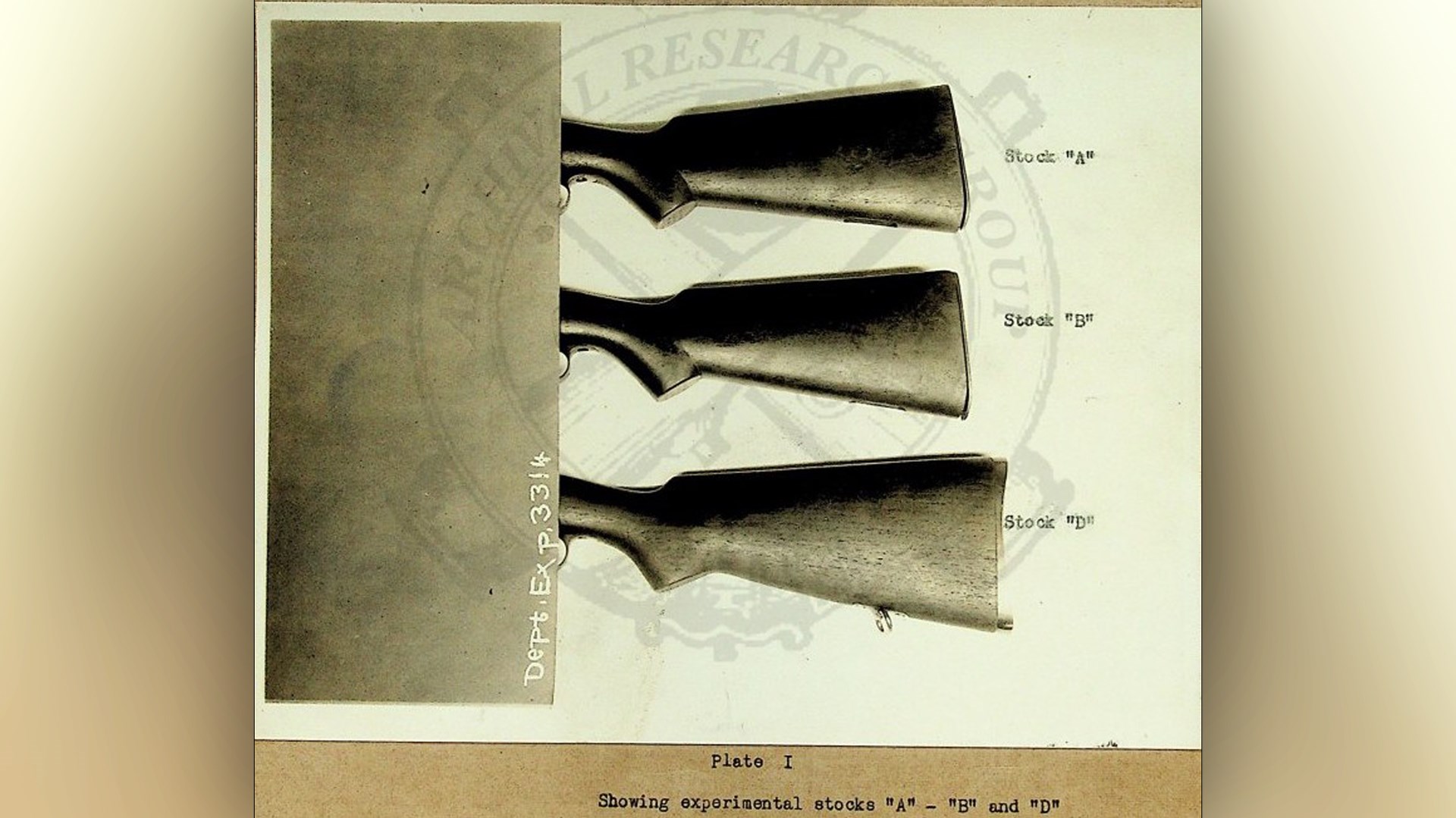 The three experimental pistol-gripped stocks. Type "A" made from a M1917 blank, Type "B" made from a M1903 blank and Type "D," a Model 1922 stock featuring the curved butt found on NRA sporter rifles.
The three experimental pistol-gripped stocks. Type "A" made from a M1917 blank, Type "B" made from a M1903 blank and Type "D," a Model 1922 stock featuring the curved butt found on NRA sporter rifles.
Throughout 1922, the Department had solicited letters from select expert shots, military competition shooters and experienced infantry officers who were provided different versions of M1903 pistol grips stocks to use during range work. The opinions were near universal, and these officers used terms such as “very valuable improvement,” “a more natural grip,” “a distinct advantage and is warmly advocated,” “conducive to better scores” and “superior to the present stock.” While some offered suggested improvements, such as comb-height changes, they strongly believed that a pistol grip would be a marked improvement.
Building off two earlier tests, in May 1923, the Department of Experiment set out to determine whether the U.S. should adopt a pistol grip M1903 stock, and if so, what features it should embody. As to what features mattered most in a new stock design, they settled on the following order of importance: the pistol grip, stock length, comb length and height of the comb.
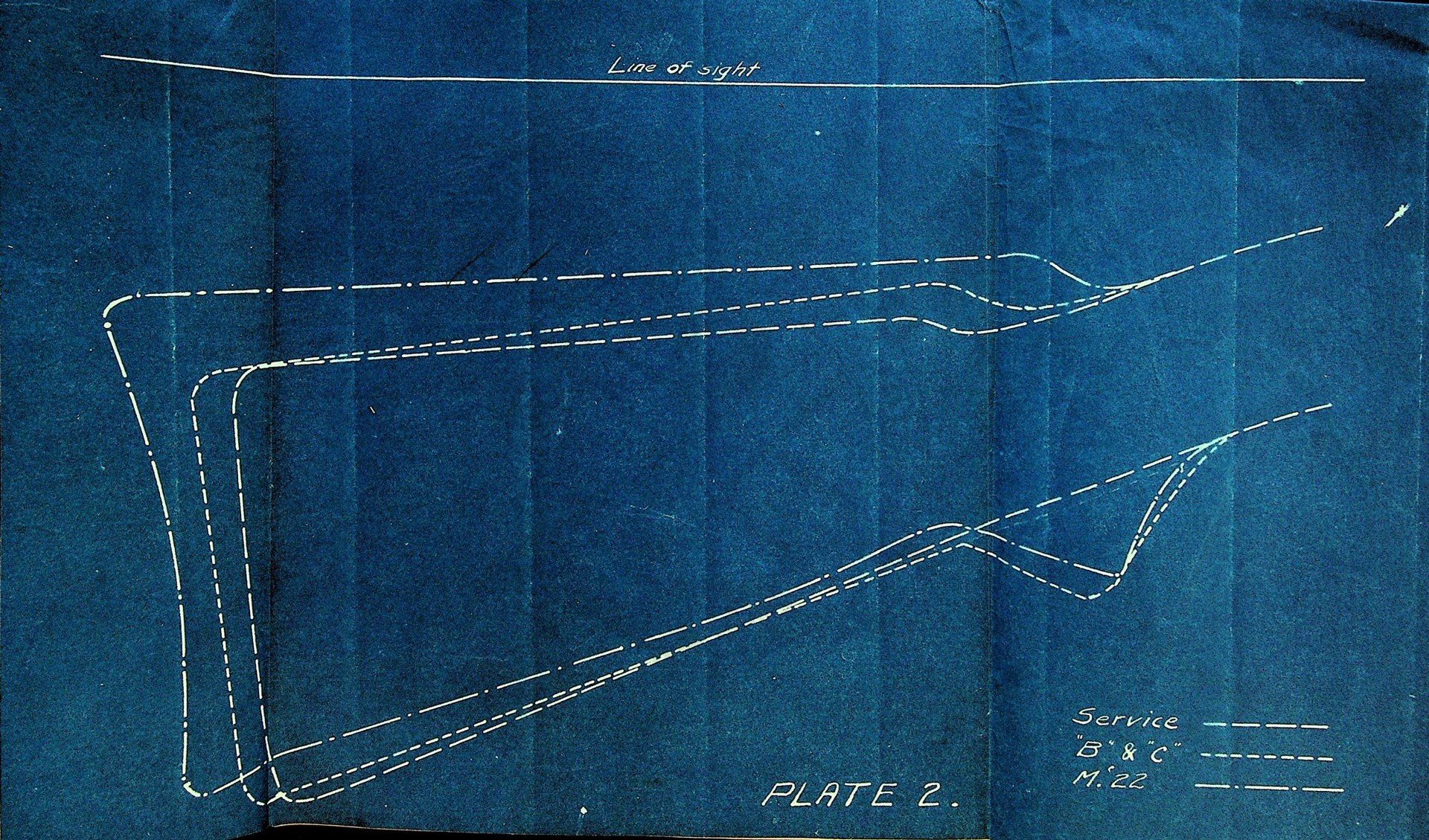 An overlay drawing showing the relative length, drop and comb height on all the tested stocks. The M1922 had a remarkably higher comb, making it ideal for use with telescopic sights, but the length caused shorter men to struggle.
An overlay drawing showing the relative length, drop and comb height on all the tested stocks. The M1922 had a remarkably higher comb, making it ideal for use with telescopic sights, but the length caused shorter men to struggle.
The Experiment
Ultimately four variants, devised during 1921 experiments, were thoroughly tested against a standard service stock:
Type A: Experimental pistol grip stock created from an M1917 stock blank
Type B: Experimental pistol grip stock created from an M1903 stock blank
Type C: Experimental straight, non-pistol grip stock otherwise with same dimensions as Type B (NOT what would eventually become the “C-Stock” that collectors know today)
Type D: Pistol grip M1922 target stock which, according to Brophy, “was like the sporting type stock (NRA), [but with] a full length forend.” This stock also featured the curved NRA style butt in place of the standard flat service one. National Match rifles fitted with such stocks were deemed “National Match Specials.”
With these four stocks, four tests were undertaken. The first was slow and rapid fire from the offhand, sitting, kneeling and prone positions, designed to “determine the features of recoil effect, rapidity and ease of bolt manipulation, accuracy of alignments, of the various types of butt stock for test in comparison with the service stock.” In this test, pistol grips were universally well-liked, particularly the Type A & Type B variants: “In slow fire all rifleman remarked upon a diminution of recoil. Furthermore, they all agreed upon the easy, natural alignment possible with both these stocks and the general comfort immediately apparent in comparison with the service stock. In all positions this was so.”
While the C stock was considered excellent, “the lack of a pistol grip condemns it with all shooters who naturally prefer a stock with a well proportioned pistol grip.” Lastly the M1922, the only actual “official” stock of the bunch, was considered a “radical departure” from the others, and while its length placed short-statured shooters at a “great disadvantage,” it left a “very good impression” on others.
The next test, perhaps recognizing the impact of snipers during the Great War and likely impact in future wars, was slow fire from the prone and from trenches with a telescopic sight mounted. In this test, perhaps unsurprisingly, the M1922 stock stood out and “proved to be by far the most satisfactory stock when the telescopic sight is used.” The length of pull (13.5”), comparatively slight drop of 0.75” and the “well moulded comb” combined to produce what the testers considered a “very satisfactory stock” that supported the jaw exceptionally well and aligned the shooter’s eye with the optic.
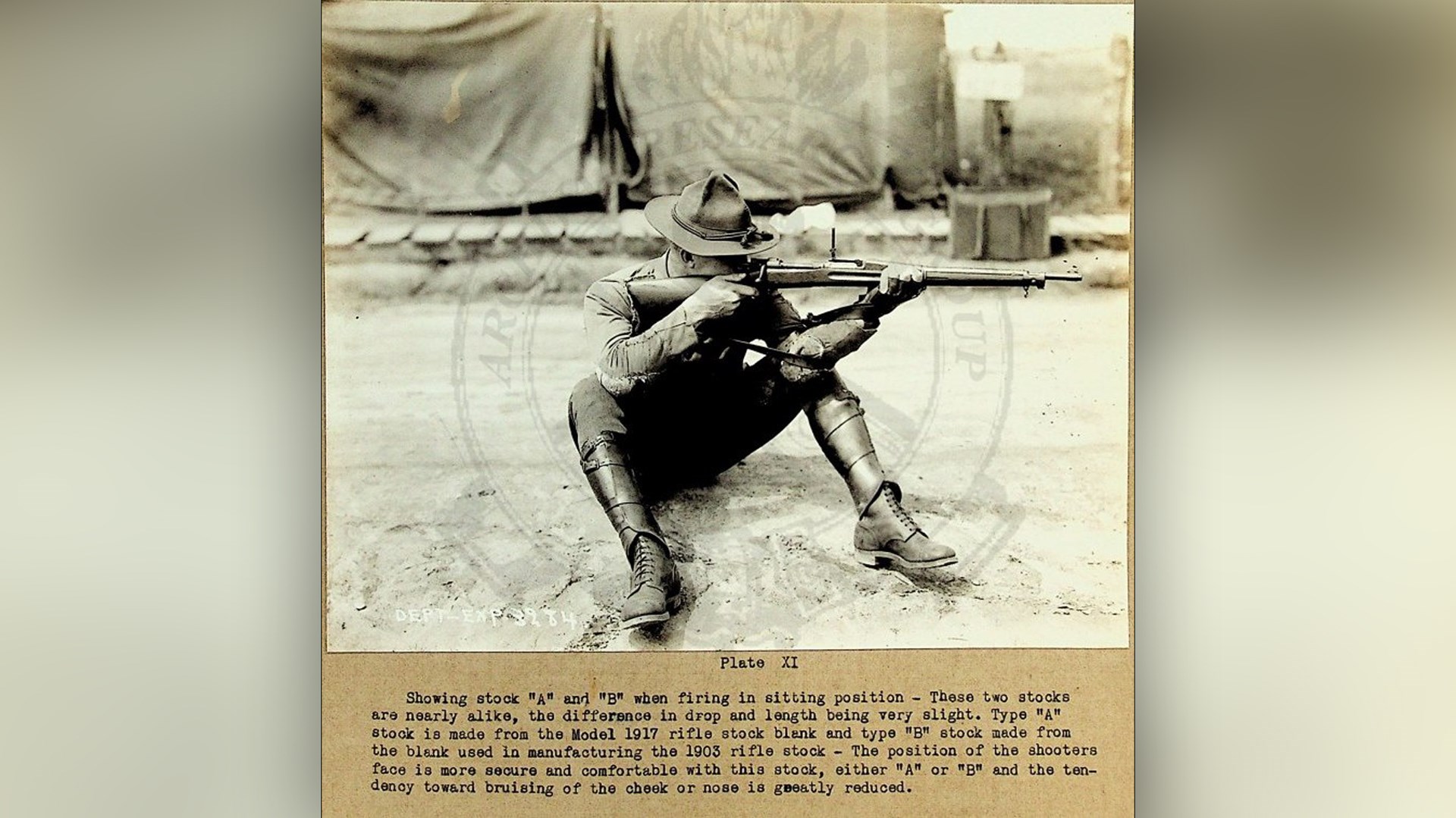 An officer using either a Type A or Type B stock. This length was found to be suitable for most shooters, regardless of height.
An officer using either a Type A or Type B stock. This length was found to be suitable for most shooters, regardless of height.
The last firing test consisted of riflemen wearing overcoats firing from a trench at targets which were “bobbing and exact point of targets appearance unknown.” The overcoats “were worn in order to ascertain the effect of heavy clothing when positioning the various stocks against the shoulder and the otherwise retarding effect that heavy clothing would have upon an easy, free movement when taking quick, snap aim”–such snap firing having been of paramount importance during World War I. In this case, the coats did prove bulky, as the first three stocks were a bit too long for “easy and natural positioning,” but it was not excessive for men of average height or greater. The M1922 stock, again, proved too long for men of short stature.
The final test cut right to the point by testing bayonet fighting. The purpose was to see if the pistol grip interfered with the ideal grip for bayonet fighting and included French, British and German rifles for comparison. In this one test, the pistol grip stocks came up short, and they were found to cause some discomfort and difficulty with getting a firm grasp when compared with the straight stocks. While it’s easy to see why this is the case, especially for the seasoned bayonet instructor institutionally familiar with decades of straight-stocked rifles, it’s also important to note that other nations that still placed emphasis on the bayonet fight found pistol grips perfectly acceptable on their rifles. The British in particular, from whom the U.S. Army derived much of its bayonet fighting techniques and training, had been using a distinctively pistol-gripped rifle since 1888.
Pistol Grip Final Thoughts
Much like the receiver sights, the consensus on a pistol gripped stock was favorable with the test reporting, “The pistol grip, except for bayonet work, is in universal favor and adds to the efficiency of the rifle.” Since it appears from the report that, in bayonet combat, the pistol grip stock cannot be handled with the same ease as can the present issue stock and since the casualties occasioned from the bayonet in war are negligible, this defect alone should not bear weight in condemning the pistol grip.
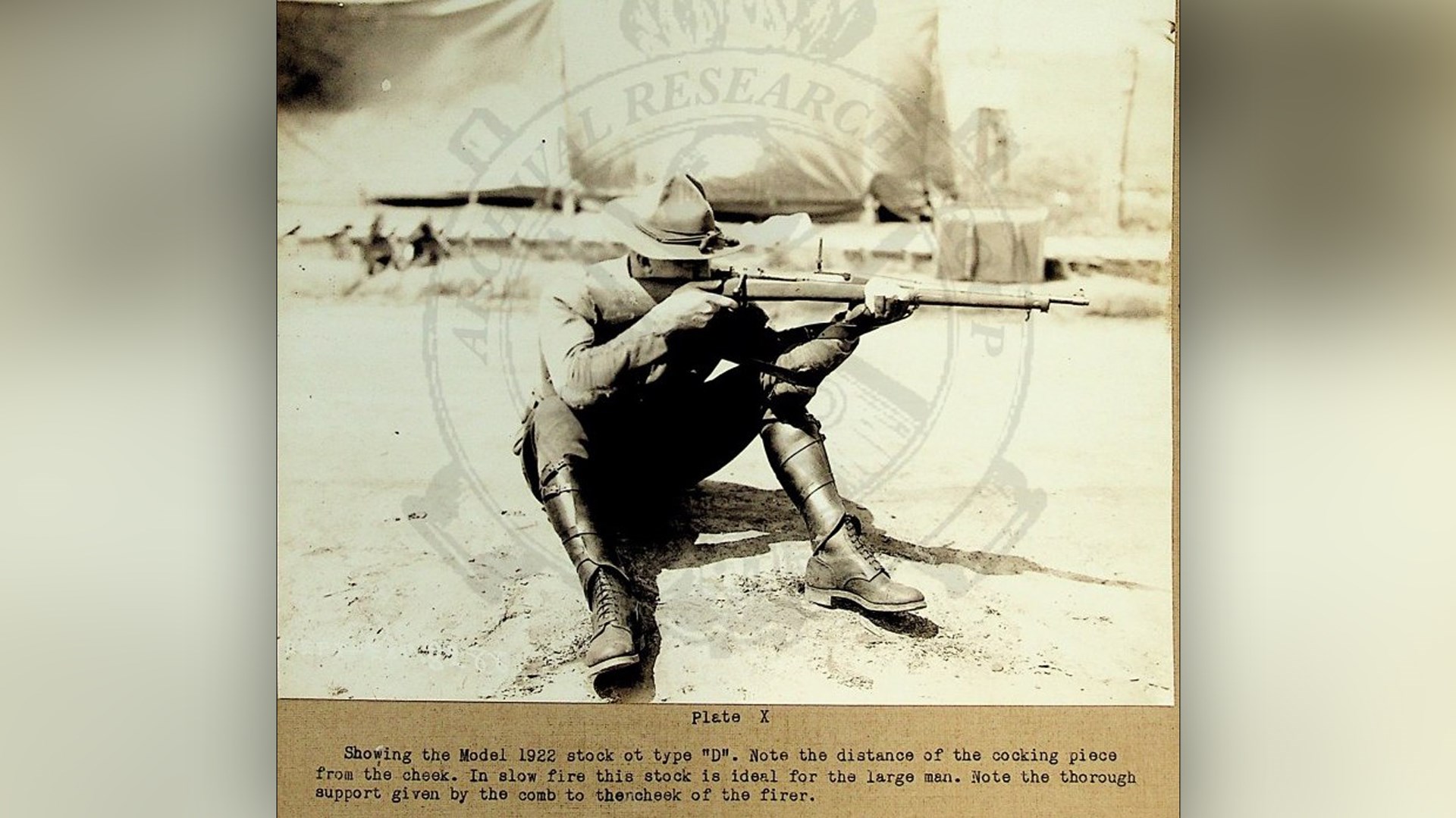 An officer using an M1922 stock. Note the lack of grasping grooves on this arsenal production stock. While “ideal for the large man” in slow fire, and providing “thorough support” to the cheek, it could be difficult to manipulate in rapid fire, especially for shorter men.
An officer using an M1922 stock. Note the lack of grasping grooves on this arsenal production stock. While “ideal for the large man” in slow fire, and providing “thorough support” to the cheek, it could be difficult to manipulate in rapid fire, especially for shorter men.
They particularly liked the pistol-grip dimensions of the M1922 stock but decried that stock as too long, especially for those of short stature. Instead, they proposed a hybrid stock that featured the M1922 pistol grip, with a length of pull no longer than 13.0625” in length–the shorter length of pull being easier to use in rapid fire. They suggested this instead of issuing various stock lengths, as the British did, because of the complication it would cause with manufacture and supply.
As the test results filtered upwards, the praise became less effusive and more pragmatic. Instead of endorsing the ideal stock dimensions dreamed up by the testers, the president of the Infantry Board instead stated, “The Infantry Board is of the opinion that a rifle stock superior to the one now issued can be made from the blanks now on hand as there are reported to be approaching three million of these blanks in storage the immediate problem is to devise the best possible rifle stock that can be made from this style of blank.”
Interestingly, however, both courses of action were ultimately acted upon. First, in 1928, the Army approved the “C” stock featuring a full pronounced pistol grip. While they never became the predominant M1903 stock, they saw heavy use on rifles created for the National Matches, and later variants saw service as stocks on the M1903A4 sniper rifle. Also, during WWII Remington–after purchasing stock blanks from the government–made “scant”-style stocks with a shallow semi-pistol grip when they hit the problem of the too-narrow stock blanks as identified by the president of the Infantry Board in 1923.
Testing A “Short” Bayonet
The M1903 of the 1920s was topped with the M1905 bayonet, an enormous cutting and thrusting implement with a 16”-long blade. This had replaced the diminutive-by-comparison bayonet for the Krag rifles, which only clocked in at approximately 11.75”. The reason for this growth was simple math: With the adoption of the M1903, gone were the days of rifles for infantry and carbines for cavalry, instead all soldiers were to be armed with one universal-length short rifle. A shorter rifle therefore required a longer bayonet in order to not lose any of the reach thought to be a critical part of bayonet fighting, so therefore the bayonet grew by almost as much as the standard rifle shrank. However, after about 15 years of use, there were some concerns that the longer bayonet was slower and more unwieldy, particularly in close-in fighting. In addition, it was patently obvious that the 16” blade was not at all useful for camp chores, where a shorter bayonet would be able to provide triple duty as a camp tool, fighting knife and bayonet.
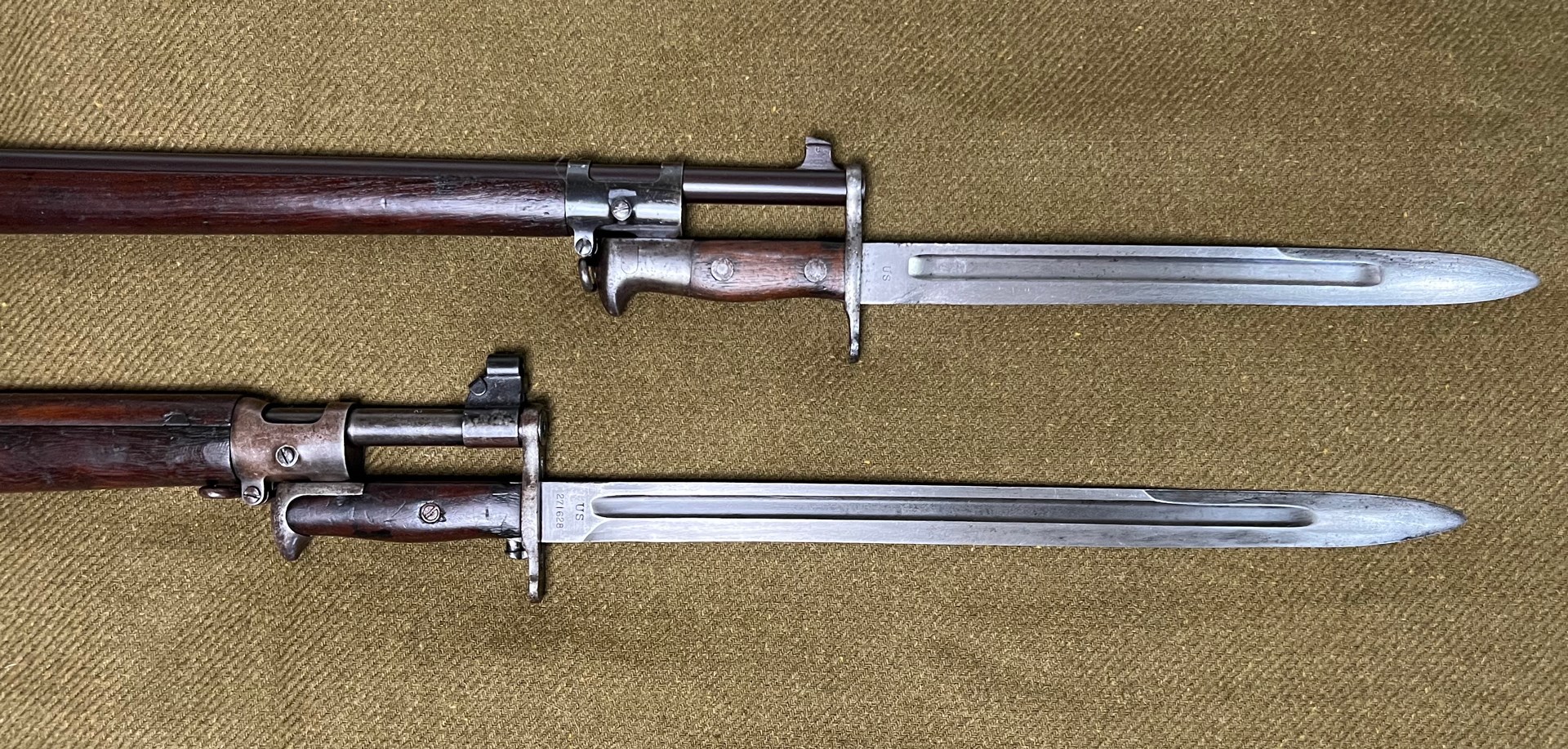 When the M1903 was standardized somewhere between traditional carbine and rifle length, it was decided to make the bayonet longer to make up for the lost reach—believed to be critical in hand-to-hand fighting.
When the M1903 was standardized somewhere between traditional carbine and rifle length, it was decided to make the bayonet longer to make up for the lost reach—believed to be critical in hand-to-hand fighting.
To put the theory to the test, 50 bayonets were created. “The experimental short bayonet is a stilleto [sic] type similar to the Swedish bayonet. It is 8.5” long, double-edged, hollow ground and polished, weighing without the scabbard, 12.5 ounces.”
The Bayonet Instructors
Ten of these bayonets were turned over to the Infantry School’s Department of Military Art, to be tested by their bayonet instructors in order to determine the following points:
- Is the double-edged bayonet desired?
- Is the short bayonet more easily handled than the long bayonet and more efficient for close fighting?
- Is the handiness of the short bayonet more desirable than the long reach of the long bayonet?
- Is the moral effect of having a long bayonet with great reach important enough to neutralize the material advantage of speed in handling the short bayonet?
- Are there any criticisms of the short bayonet scabbard?
- “An opinion of the relative merits and efficiency of the long and short bayonet for use in bayonet fighting on our present service rifle against the type which would be encountered in foreign armies.”
These instructors tested the bayonets first by using them against dummies, in order to test the comparative ease of penetration and withdrawal, and in “all the movements of bayonet combat, in every way possible.” Just like sensational modern ballistic gelatin or meat-target testing, the bayonet instructors noted that the dummy test “only approaches actual conditions, as the obstruction and resistance caused by the bones of the human body is greater than that of the dummies.” They further clarified that, while they sought to establish “a sound basis upon which to render opinions,” “it must be admitted that many of these questions are chiefly matters of opinion, as actual combat work is impossible in conducting a test.”
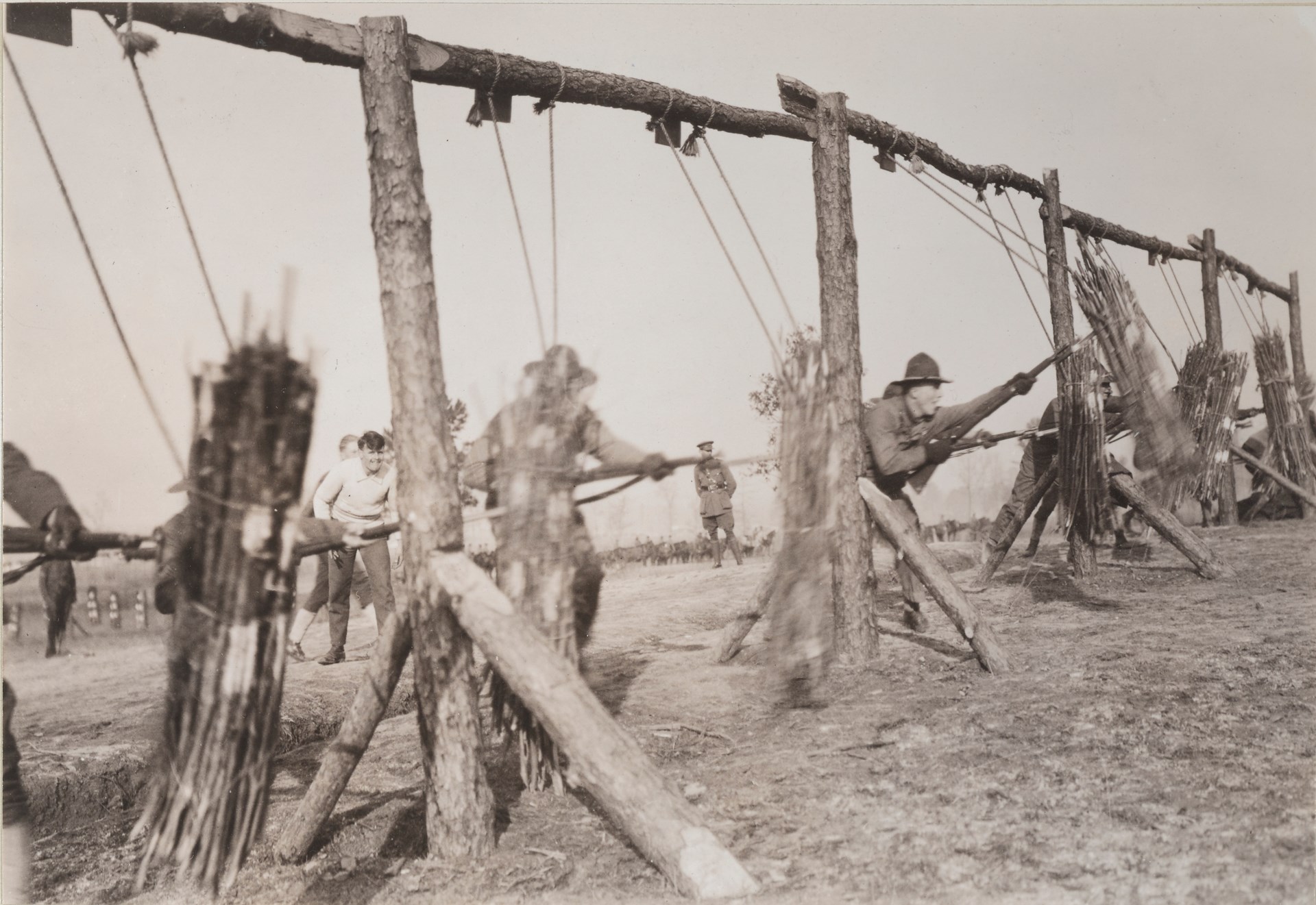 Bayonet training taking place on bundled wooden dummies, teaching the importance of both the thrust and withdrawal on a dynamic target.
Bayonet training taking place on bundled wooden dummies, teaching the importance of both the thrust and withdrawal on a dynamic target.
They came away from this initial test fairly unimpressed with the experimental bayonet. They felt that the “present weapon is very easily handled, and the balance is so nearly the same with either bayonet that the difference in speed and ease of handling is negligible.” In comparison, they felt that the only time the short bayonet had an edge was when “opponents are struggling body to body,” and that “The relatively longer reach of the long bayonet is of great moral[e] value to the bayonet fighter, increasing his confidence in himself and his weapon: the main desideratum in all bayonet training. This, it is believed, more than offsets the slightly greater efficiency of the short bayonet in body to body fighting.”
They then sent the bayonets to battle on the bayonet fencing ground, or at least they approximated such combat by using wooden training rifles modified to the appropriate length. These seasoned instructors, who swapped rifles after each tilt, fought at long range, mid-range, long & mid-range (a mix of parry and thrust), and finally in close-in fighting. Based on the scored hits, they concluded that the long bayonet performed better at both long and mid-range and was equal to the short bayonet in the close fight.
Men In The Field
Thirty bayonets were then turned over Company E of the 29th Infantry Regiment to be carried on all occasions on which they were under arms.
It is apparent from the testing that the enlisted personnel rather liked the short experimental bayonets, although there does not appear to be any first-hand accounts in the records. Instead, the results filtered through the officers of the 29th, and while they were more positive than the bayonet instructors, they were mixed. The company commander and one of the lieutenants came away with overall favorable opinions but noted concern about the lessened reach. Colonel Goodale, commander of the 29th Infantry Regiment was non-committal, but he wisely noted two things. “One advantage of this experimental bayonet that occurs to me is that, if detached from the rifle, it would seem to be well adapted for use as a trench knife.” He then noted that which is the better bayonet ultimately depends on how bayonet training will be taught and which range will be emphasized as ideal.
The Department of Experiment reviewers took a full paragraph to discount the apparent positive feelings of the enlisted men towards the experimental bayonet:
“The point of view of troops towards bayonets in peace time in garrison and field service, especially green men who have not had war experience, is much different from the attitude of a trained soldier under battle conditions. When a bayonet is not contemplated by the enlisted men except as an extra piece of equipment to carry when under arms, the shorter, lighter and the more convenient as an auxiliary tool, the better he likes it. Development of the aggressive spirit and confidence in the use of the weapon, resulting from thorough and correct training in the technique of bayonet fighting, cause the soldier to judge his bayonet as a valuable fighting asset and not as an extra piece of equipment to carry in garrison. This latter view point seems to be preeminent in the reports from Company ‘E’, 29th Infantry.”
Final Shots
They then rounded out with a firing test and a test of the balance point. While the rifles mounting the short bayonet shot slightly better while advancing against pop-up targets – “indicating that it is slightly easier to ‘get on the target’ quickly with the short bayonet” – the testers felt the rifle with the standard bayonet was almost perfect and “nearly under the center of the rear sight base, making it easier to handle than most rifles of foreign armies, which have longer barrels, and heavier bayonets, proportional to length … .”
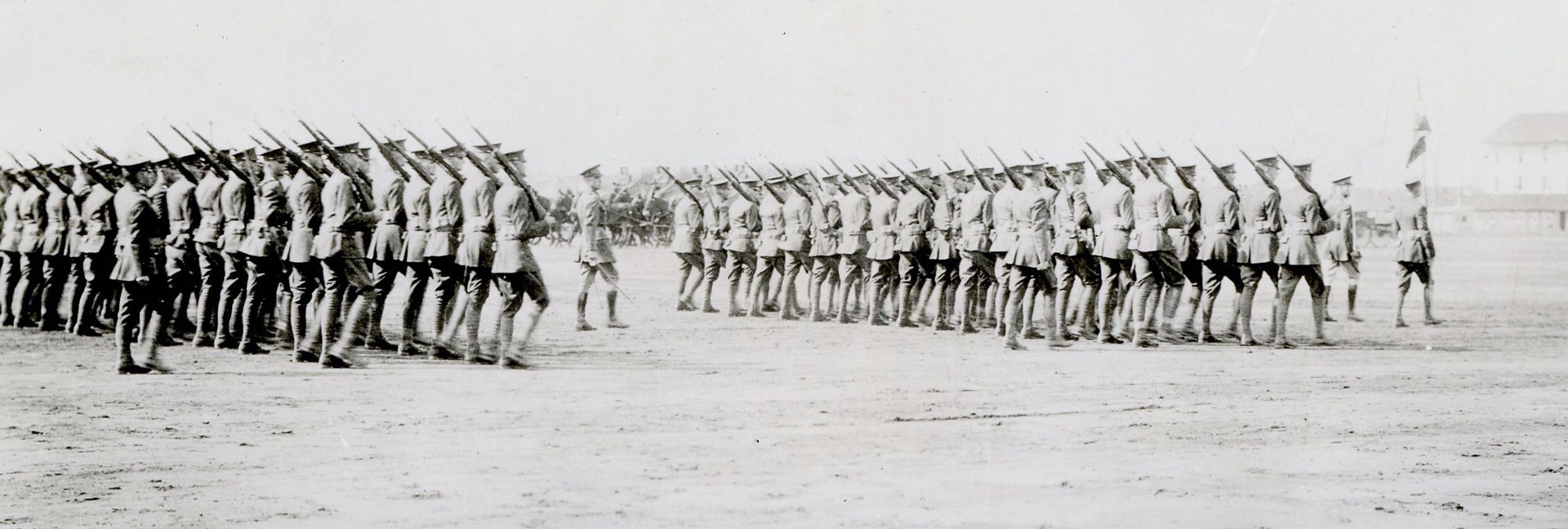 Men of the 29th Infantry Regiment at drill while stationed at Fort Benning. The experimental bayonet was apparently quite liked by many of the enlisted personnel who were given it for testing.
Men of the 29th Infantry Regiment at drill while stationed at Fort Benning. The experimental bayonet was apparently quite liked by many of the enlisted personnel who were given it for testing.
In the end, the Department of Experiment determined that “Reducing our total length 7.5” would materially affect the reach of our bayonet against that of nearly any foreign nation,” and a short bayonet should not be adopted, despite it being better-suited for snap-firing, more convenient to carry on the waist, being slightly easier to withdraw from the target and better-suited to close conditions and non-rifle-mounted work.
Ultimately, they sang the praises of the issue M1905 bayonet and called it “[A] more efficient weapon on the service rifle than the short bayonet, as the difference in speed in handling the two weapons is negligible, and the one with the greater length permits more efficient, confident, and powerful parries, which are a necessary part of the offensive thrust.”
They also noted the intangible aspects of a lengthy bayonet when they envisioned the next major conflict where, “Our army in time of war will consist of a very large percentage of untrained men, in which case the morale factor is more important than with regular troops. The importance of bayonet training is largely to develop morale, confidence, and the desire to close with the enemy, which can be accomplished better with our present bayonet, than with the short experimental bayonet.”
Like the aperture sights on M1903 variant rifles, it would take World War II to bring about a short M1905 bayonet. In the spring of 1943, production of the M1 bayonet, with a 10” blade, began. In addition, approximately 1 million 16” M1905 bayonets were recalled and 6” of blade lopped off in order to bring them in line with the new standard.
A Little Ahead Of The Times
Out of these three tests, the Department of Experiment went two-for-three when it came to their suggestions eventually being carried out by the slow-to-change Army. In approximately 20 years’ time, on the battlefields of World War II, all three tested ideas became the prevailing norm. M1 rifles, M1carbines, M1903A3s and other firearms came with mounted aperture sights from the factory. Pistol grips found a home on not only the primary rifle and carbine of American forces, but also their sniper rifle, the M1903A4. The only miss that the Department of Experiment had was their recommendation to retain the long 16” bayonet because of its enhanced reach. After the prevailing logic of bayonet fighting shifted over the years, the bayonet was eventually shortened to 10”, although not all the way down to the tested 8”.
While their suggested changes were far from immediate, they did gather valuable data that likely helped inform later decision-making. In this way, it appears that the officers of the Department of Experiment were just a little ahead of the times when it came to these specific innovations. These three also just scratch the surface of what the department worked on, with dozens of other tests on things such as hand grenades, ammunition loads, luminous sights, telescopic sights, recoil absorption, oils and flash hiders. In 1922, they also tested the Pedersen Device in order “to determine whether the Caliber .30 Model 1918 pistol (Pederson Device) [sic] has sufficient merit to warrant its adoption as a part of Infantry equipment”–the subject of a future article.
All test documents, and accompanying photographs, are located in the National Archives and were digitized as part of Archival Research Group’s quest to preserve these fragile documents for posterity.












